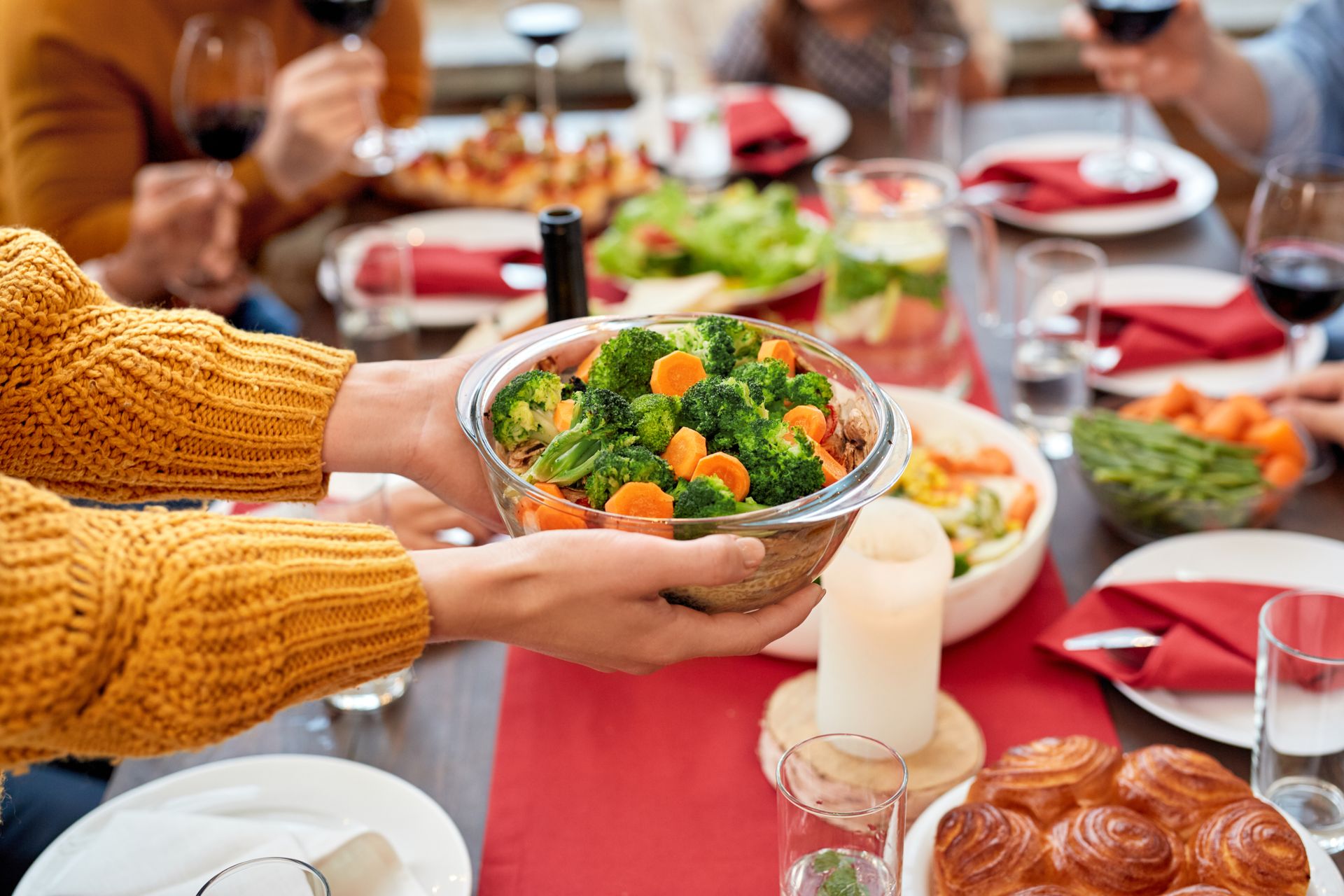The holiday season is stressful enough, but if you’re also watching your blood sugar levels, this time of year can be particularly difficult.
From traditional holiday dishes to desserts, it takes some extra effort for diabetics to keep their blood sugar levels stable during holiday eating. The good news? We’re here to help!
Use our 7 tips to promote blood sugar levels within a healthy range during the holidays.
Note: this post should not be taken as medical advice. Before you make any changes to your diet, or if you have specific questions, please consult with your physician, endocrinologist, or registered dietitian.
These tips are meant to provide general ideas and may not be what works best for all individuals. Everyone’s bodies respond differently to foods, diets, and lifestyle habits.
1. Try the plate method
The plate method can be a great tool to use to help create a balanced meal without necessarily needing to weigh or measure foods, count calories, or track carbohydrates.
The goal for the plate method is to be able to fill your plate with holiday foods but in a balanced way. Here’s how to do it:
Step 1: Fill half of your plate with non-starchy vegetables
Non-starchy vegetables are low in carbohydrates and high in fiber, which can help keep blood sugars stable.
Examples of non-starchy vegetables include broccoli, cauliflower, green beans, peppers, leafy greens, tomato, zucchini, yellow squash, okra, and asparagus.
Step 2: Fill 1/4 of your plate with starchy vegetables or grains
Carbohydrates have the greatest effect on blood sugars. After being digested, carbs break down into glucose, which then enters your bloodstream and causes a rise in blood sugar levels.
Limiting carbs and starchy vegetables to just 1/4 of your plate is an easy way to reduce portion size and help prevent a large spike in blood sugar levels.
Examples of carbohydrates and starchy vegetables include:
- Bread, rolls, stuffing, tortillas.
- Grains, such as quinoa, rice, oatmeal, barley, and couscous.
- Starchy vegetables, including potatoes, sweet potatoes, yams, plantains, peas, corn, winter squash (like acorn and butternut), pumpkin, and parsnips.
- Desserts, including cookies, cake, brownies, pies, and pastries.
Note that while legumes and beans also contain carbs, they can fit into either the carb or protein category.
Want mashed potatoes and stuffing? You can have both, just reduce the portion sizes so that together they still only make up 1/4 of your plate.
Step 3: Fill the remaining 1/4 of your plate with protein
Protein foods include both animal sources, like turkey and beef, as well as plant-based proteins, like tofu and beans.
For heart health, it’s recommended to choose lean protein foods that are lower in saturated fat, such as turkey, lean ground beef, and fish.
Examples of protein foods include chicken, turkey, eggs, fish, shellfish, lean beef (round, sirloin, flank, or tenderloin), lean pork (center loin chop or tenderloin), milk, cheese, cottage cheese, soy products, beans, and lentils.
Step 4: Choose water or sugar-free beverages
Soda and juice are high in sugar, which can lead to spikes in blood sugar levels. In contrast, water is calorie- and carb-free, so it’s a much better option for keeping your blood sugar level stable.
Want something with more flavor? Opt for beverages that are low-sugar or sugar-free, such as unsweetened tea (hot or cold), unsweetened sparkling water, or unsweetened coffee.
Note: low-sugar beverages that I like include Polar® seltzers, Hint® water, Pure Leaf® unsweetened iced tea, and Zevia® zero calorie soda (which is sweetened with Stevia!)
2. Limit your alcohol intake
The American Diabetes Association recommends limiting alcohol intake to no more than 1 or 2 alcoholic drinks per day – and no more than 1 drink per hour.
While drinking recommendations are the same for adults with or without diabetes, there are still some important safety measures to consider if you do have diabetes.
As drinking can affect blood sugar levels, it’s important to only drink if your blood sugars are well-controlled and to never drink on an empty stomach.
The reason drinking with food is important is that alcohol prevents the liver from making sugar. As a result, drinking on an empty stomach can lead to hypoglycemia (potentially dangerous low blood sugar).
Additionally, alcohol may negatively interact with certain diabetic medications.
Some diabetic medications lower blood sugar levels by stimulating the pancreas to make more insulin or giving the body more insulin. If the blood sugar is lowered by alcohol while the body has more insulin, this can also lead to hypoglycemia.
In contrast, drinking more than 1-2 alcoholic beverages or consuming beverages that are high in sugar due to mixers (like soda or juice) can lead to an increase in blood sugar levels due to the carbohydrate content of the beverage.
Be sure to ask your doctor, endocrinologist, or pharmacist about potential alcohol-medication interactions.
Better Options
As mentioned above, blood sugar levels may increase due to the carbohydrate content of the beverage. So what are some lower-carb alcoholic options?
In general, light beers, dry wines, and hard spirits (like whiskey) will be lower in carbs than heavy, sweeter drinks.
For example, Michelob ULTRA Super Light Beer contains just 95 calories and 2.6g of carbohydrates.
Mixed drinks are more difficult as they often add sugar in the form of juice, soda, or simple syrup. For example, Jose Cuervo® Margarita mix contains 28 grams of carbs in just 4 ounces!
3. Stay on schedule
It’s not uncommon to hear people say that they’re “saving up” for their holiday feast by skipping their other meals that day.
While it may sound like a good idea, skipping meals (like breakfast) and eating more in the afternoon and/or later hours of the day have been linked with increased blood sugar levels in individuals with type 1 diabetes.
Furthermore, a study of individuals with type 2 diabetes found that those who regularly skipped breakfast had overall worse blood sugar control.
As a result, it’s best to still eat regularly throughout the day to help keep your blood sugar levels stable.
4. Have a plan for dessert
Most traditional desserts are high in simple carbs that will raise blood sugar levels.
While you don’t have to skip dessert altogether, it is helpful to have a plan going into the night to avoid overeating at dessert. Here are some tips:
- Decide ahead of time on one dessert that you’re going to have.
- Make a plan with your significant other or family member to share a dessert.
- Ask to have your piece cut in half if you don’t feel comfortable sharing a piece with someone else.
- Skip the ice cream and whipped cream on the side.
- Place your dessert on a dessert plate or napkin rather than on a large dinner plate. This way, you won’t notice the smaller portion size as much.
- After you grab your dessert, walk away from the dessert table to avoid going back for more.
- Bring a lower-sugar dessert that you feel comfortable eating. Chances are someone else will also be grateful to have a lighter option.
5. Lighten up your recipes
Many holiday recipes can be easily lightened up by reducing the amount of sugar, carbs, and/or fat.
If you’re going to a party, bring your favorite lightened-up holiday recipe to share. This way you may feel more confident about choosing a healthier choice at the event.
Here are some ideas:
- Whether you’re making samosas or onion pakoras for Diwali, turkey for Thanksgiving, or latkes for Hanukkah, try them baked instead of fried.
- Instead of having a full slice of pie, try to reduce the portion with our lighter pumpkin pie bars.
- If your family serves soup during your holiday get-together, try our spin on matzo ball soup.
For more ideas on how to lighten up traditional holiday dishes, view our previous post.
6. Stay active
During the holidays, there’s so much going on that it’s easy to forget about physical activity.
Studies have shown that moderate activity, even just 20 minutes of walking after dinner, can help reduce post-meal blood sugar levels.
So rather than sinking into the couch after your meal, get a group together to go for a walk.
And don’t forget about the rest of the holiday season either! Put together a realistic exercise routine to help keep you active during the holiday season. It will go a long way in preventing weight gain and keeping your blood sugars stable!
7. Track with the Lose It! app
It is recommended for people with diabetes have a guideline for how to monitor their carbohydrate intake.
One way to monitor carbohydrate intake is by using the carbohydrate counting method.
With the Lose It! App, you can keep track of how many carbohydrates you are eating throughout the day to help keep your portion sizes in check.
With a Premium Lose It! account, you can keep close daily track with the “Carb Tracking” feature
If tracking, make sure to talk with your dietitian, physician, or endocrinologist to see how many carbohydrates a day is right for you.
The Bottom Line
The holidays can be a stressful time regardless, but they can feel more daunting when you’re also trying to manage your blood sugars.
We hope our seven tips will provide you with some additional support so that you can feel more confident eating during the holidays.

